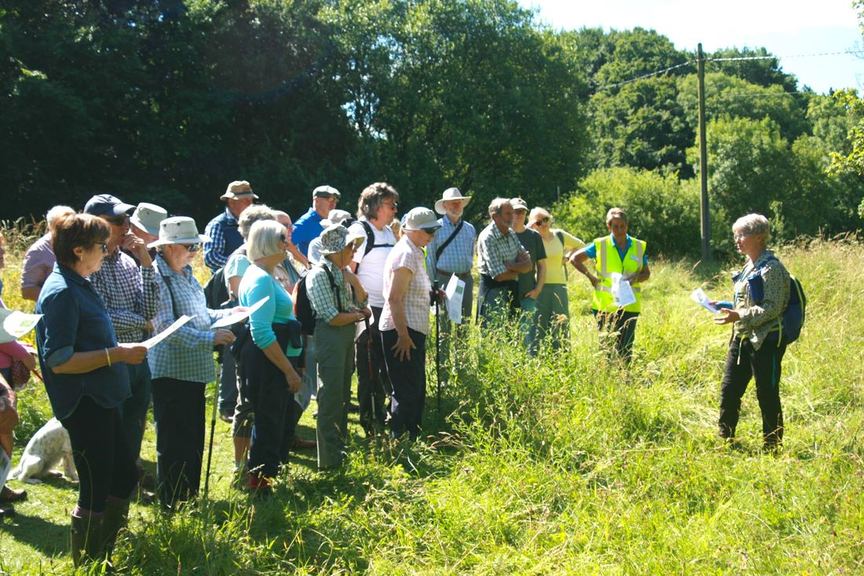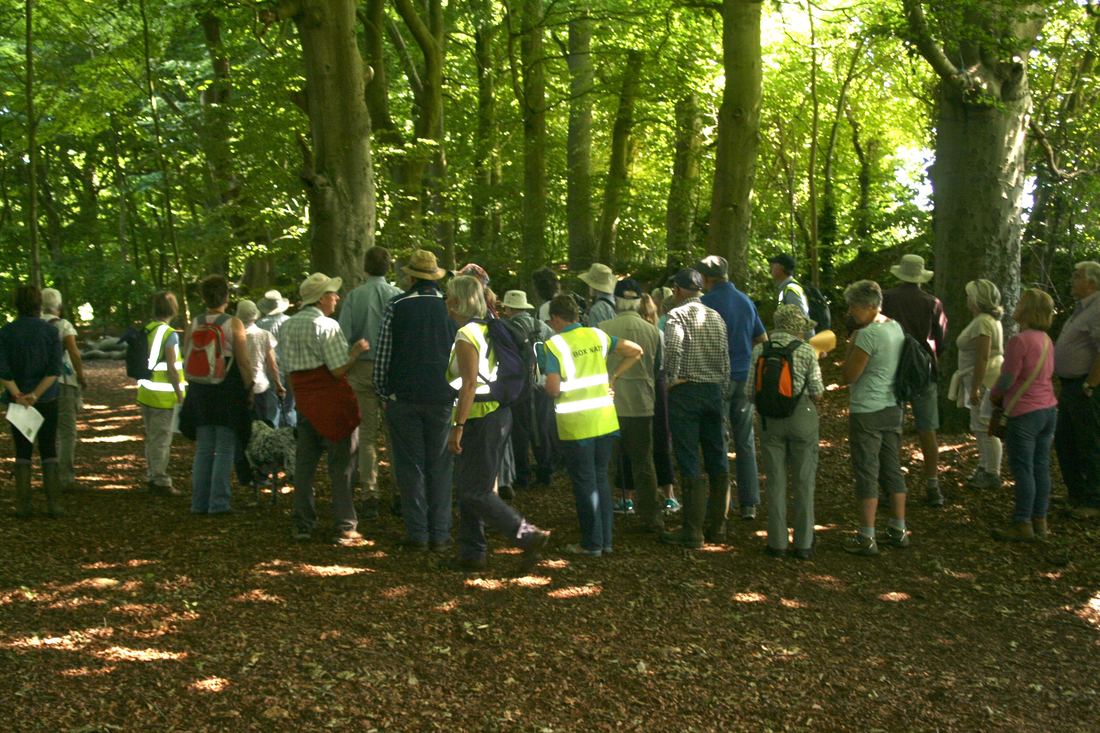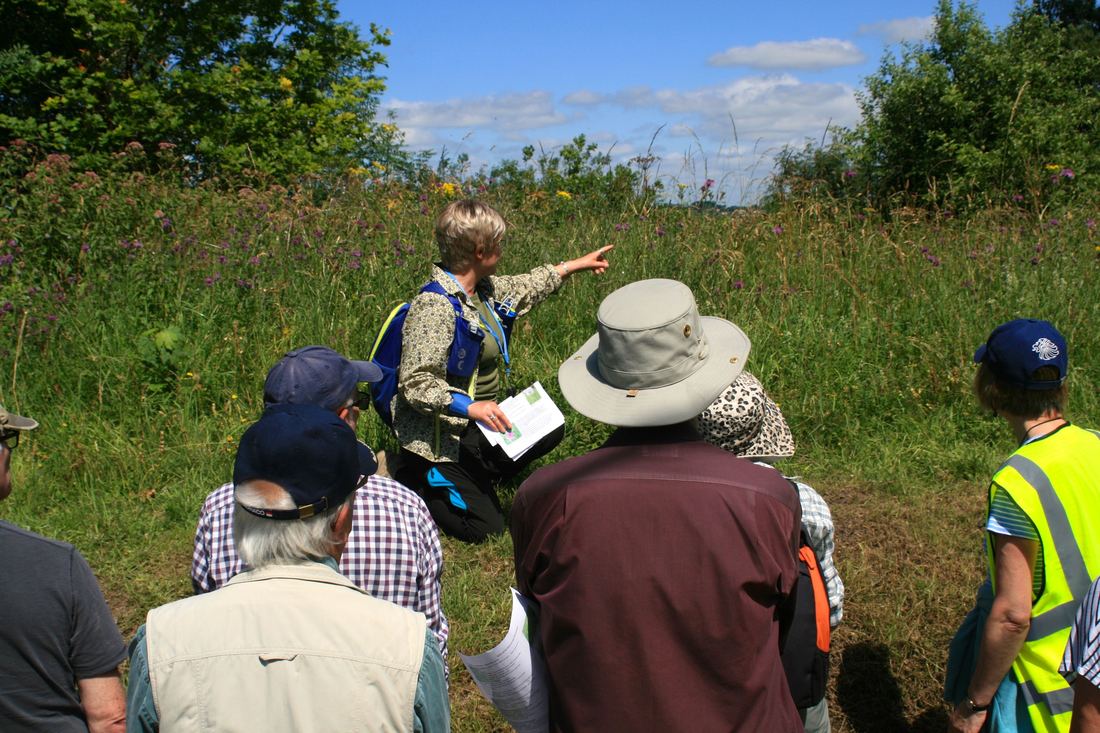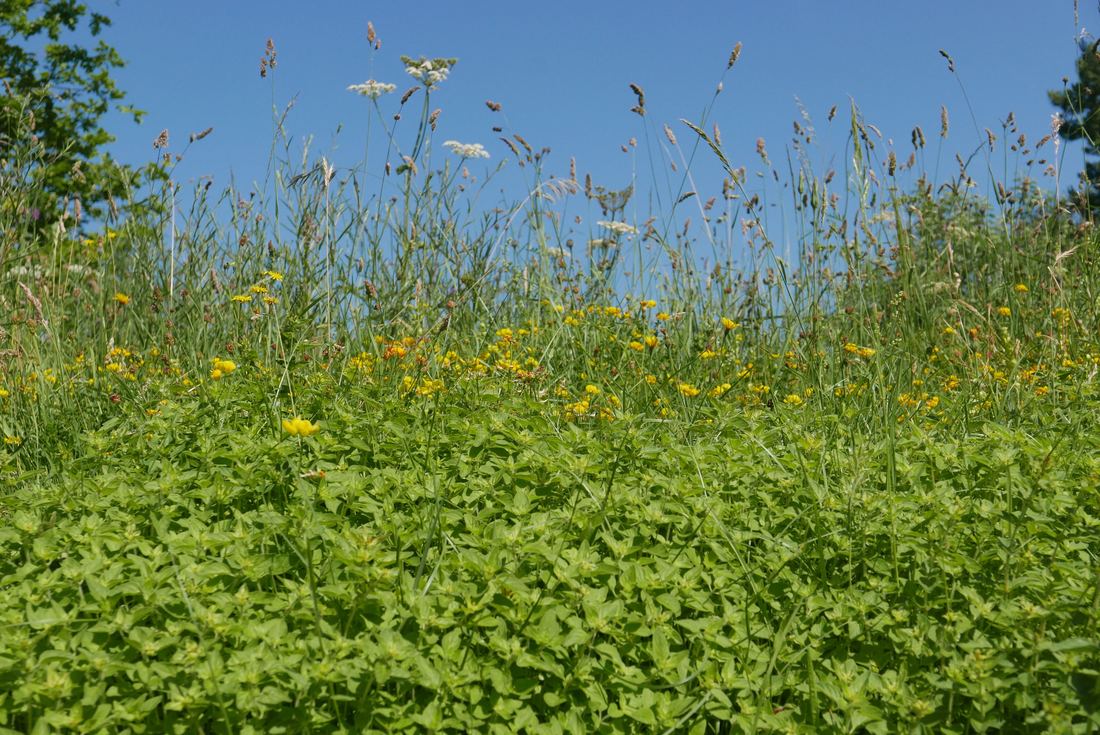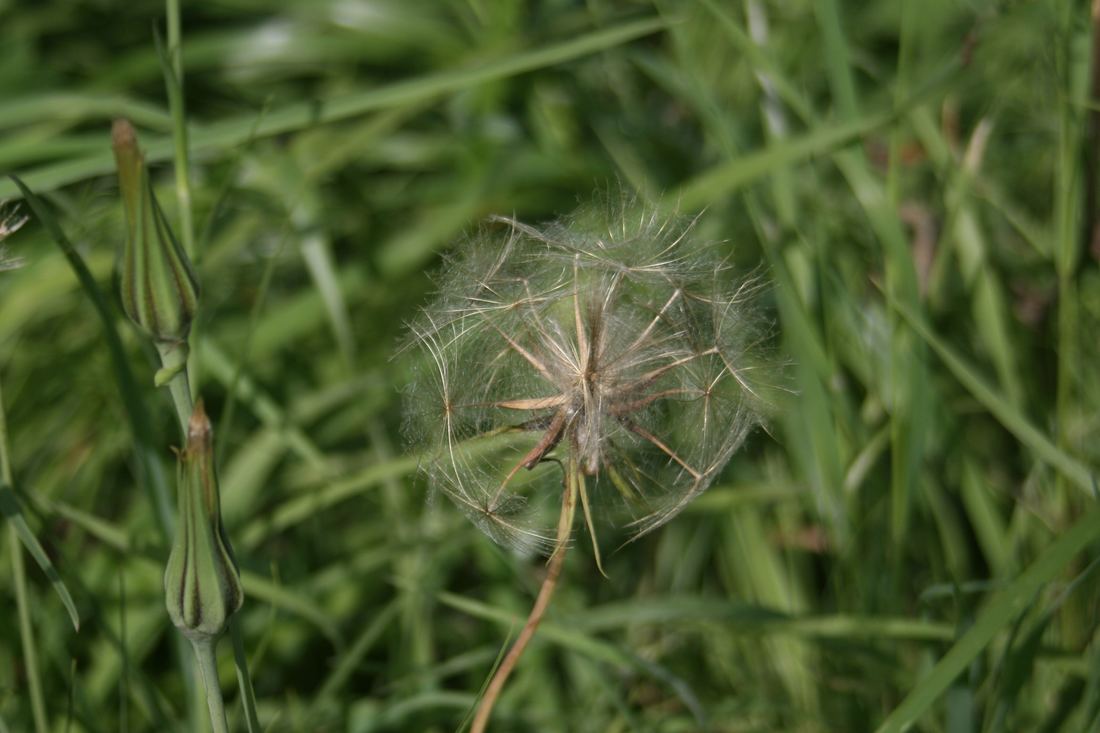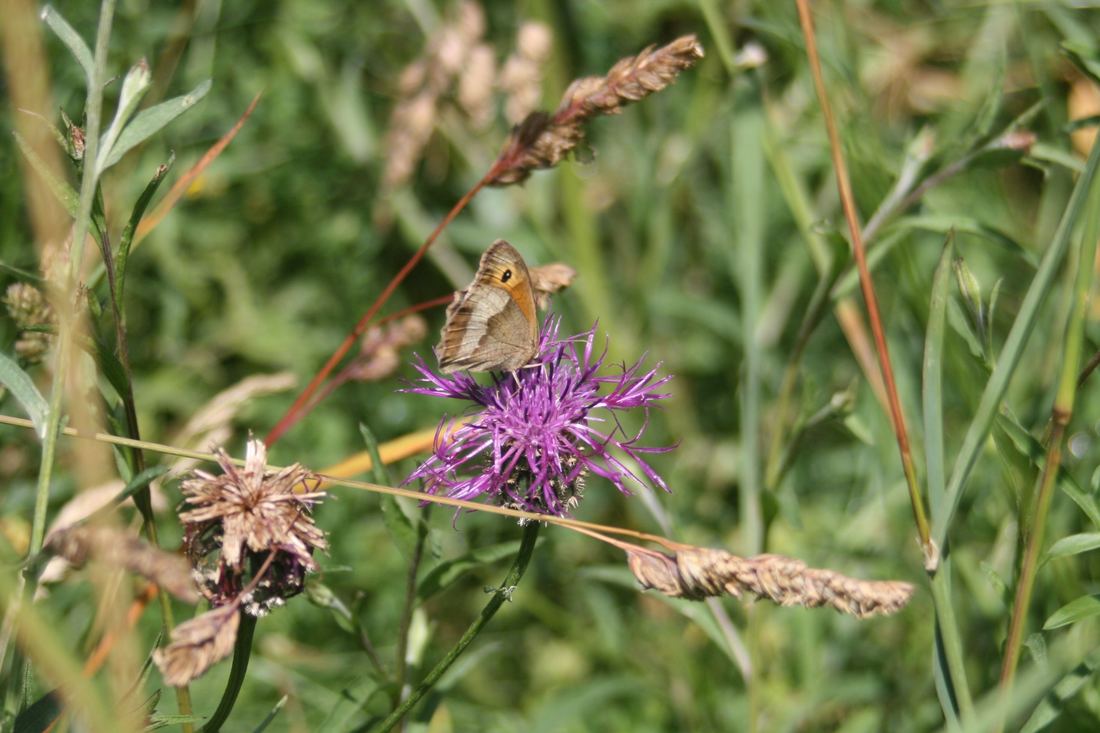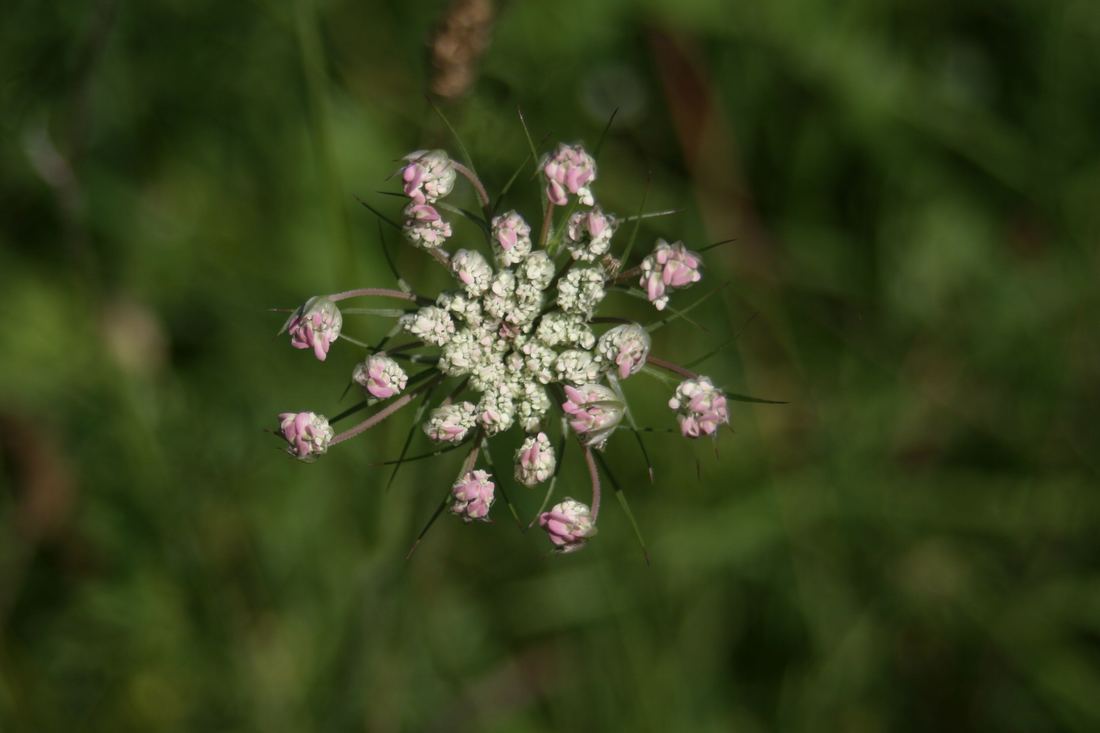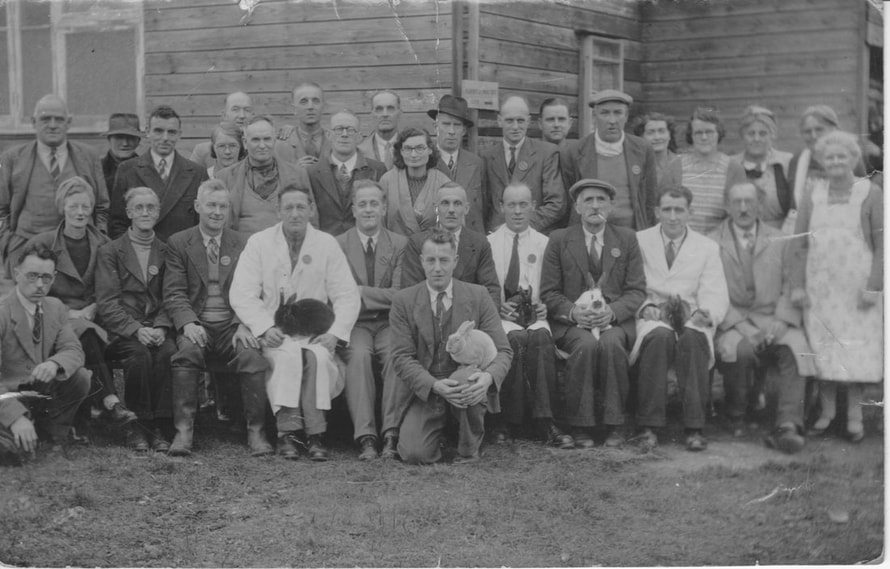Box Hill Common Trail Alan Payne Photos courtesy Carol Payne July 2017
The second history trail in 2017 was introduced by Steve Wheeler from Box Hill, led by Viki Hess from Rudloe and concluded by Dave Wright of Rudloe. We started by considering the difference between wasteland (countryside) and common land (where certain people had specific rights to use and graze animals there).
Box Hill Common Protection Society, 1976
In 1976 local people feared the residential development of much of Box Hill by builder George Lacy, who owned Grove Farm. He had flattened The Tumps and fenced in a small area. Harold Bishop started a petition to Box Parish Council. Fred Couzens wrote from Maesteg, South Wales, I was living on Box Hill for 58 years and kept 7 or 8 goats, chickens, a pony and had 2 sheds on Box Hill Common. We used to collect windfalls of firewood from the woods with permission by FG Neate. But then came a problem in his letter, We used to pay FG Neate 1s per year. He was the owner of the Common then. In other words the occupation was not common land but a casual tenancy and the Commons Commissioner decided in 1976 that it didn't fulfil the requirements for being common land.
Steve Wheeler and others formed the Box Hill Common Protection Society and tried to prove that the area was waste of the manor. They won a case in the Court of Appeal in June 1978 but the decision was overturned yet again because nobody had registered commons rights. With the support of Box Parish Council a public meeting was held in the Selwyn Hall on 11 July 1978. The hall was packed to capacity, over 300 people attending, some inside, others craning their heads to hear from the foyer and more outside listening to events with the windows open. The debate was heated.
George Lacy made a significant and generous proposal. He offered to sell the land to the parish at a value determined by the District Valuer with the promise that Box Parish Council would allow him a small caravan site at Grove Farm. His proposal saved the day and Box Parish Council were persuaded to fund the acquisition by a two-year incremental precept on the rates, the deal being finalised for the sum of £3,000.
Box Hill Common Management Committee
With assistance from Peter Thoday and Joan Woodgate, the next step was to decide how to manage the land. A joint committee of the residents and Box Parish Council was formed with representatives from Box Hill Common Protection Society, members of the public, Box Parish Council, Box School and Box HIghlands School.
The stated object of the society was The preservation of the Common as an open space for the recreational and leisure use of the inhabitants of the Parish of Box. The rules for the usage of the Common were outlined as:
No motor vehicles, no overnight parking, no dumping or tipping, no unauthorised planting or cutting, fires and grazing only with permission. The top common was to be cut twice a year, the lower common was left natural to preserve the orchids there.
The first public activity was a Public Womble on 17 March 1979 to pick up rubbish.
Box Hill Common Protection Society, 1976
In 1976 local people feared the residential development of much of Box Hill by builder George Lacy, who owned Grove Farm. He had flattened The Tumps and fenced in a small area. Harold Bishop started a petition to Box Parish Council. Fred Couzens wrote from Maesteg, South Wales, I was living on Box Hill for 58 years and kept 7 or 8 goats, chickens, a pony and had 2 sheds on Box Hill Common. We used to collect windfalls of firewood from the woods with permission by FG Neate. But then came a problem in his letter, We used to pay FG Neate 1s per year. He was the owner of the Common then. In other words the occupation was not common land but a casual tenancy and the Commons Commissioner decided in 1976 that it didn't fulfil the requirements for being common land.
Steve Wheeler and others formed the Box Hill Common Protection Society and tried to prove that the area was waste of the manor. They won a case in the Court of Appeal in June 1978 but the decision was overturned yet again because nobody had registered commons rights. With the support of Box Parish Council a public meeting was held in the Selwyn Hall on 11 July 1978. The hall was packed to capacity, over 300 people attending, some inside, others craning their heads to hear from the foyer and more outside listening to events with the windows open. The debate was heated.
George Lacy made a significant and generous proposal. He offered to sell the land to the parish at a value determined by the District Valuer with the promise that Box Parish Council would allow him a small caravan site at Grove Farm. His proposal saved the day and Box Parish Council were persuaded to fund the acquisition by a two-year incremental precept on the rates, the deal being finalised for the sum of £3,000.
Box Hill Common Management Committee
With assistance from Peter Thoday and Joan Woodgate, the next step was to decide how to manage the land. A joint committee of the residents and Box Parish Council was formed with representatives from Box Hill Common Protection Society, members of the public, Box Parish Council, Box School and Box HIghlands School.
The stated object of the society was The preservation of the Common as an open space for the recreational and leisure use of the inhabitants of the Parish of Box. The rules for the usage of the Common were outlined as:
No motor vehicles, no overnight parking, no dumping or tipping, no unauthorised planting or cutting, fires and grazing only with permission. The top common was to be cut twice a year, the lower common was left natural to preserve the orchids there.
The first public activity was a Public Womble on 17 March 1979 to pick up rubbish.
Exploring the Nature Trail
The Box Hill Common Nature Trail was created in 1982 as a permanent way of encouraging people to enjoy and appreciate this special environment. The Nature Trail was devised and drawn up by Ann Skinner of Bath University and an informative guide was printed. Before and after World War 1, hay cut from the middle common meadow was used to feed horses that worked in the quarry. Such traditional management is a requirement of the specialised limestone plants which still survive here.
Under the leadership of Viki Hess we were treated to a fascinating exploration of the site, including some folklore and historic uses of plants. We examined the species to be seen in the meadow on the middle common finding a huge variety of plants. Amongst these Greater Knapweed which provides food for up to 160 animal and insect species, Yellow Rattle, Bird's Foot Trefoil, Rock Rose, Lady’s Bedstraw and Wild Marjoram, to name but a few, were in abundance.
Viki led us around the upper common where the magnificent trees of the beech belt provide cover and shelter for wildlife and form part of the mosaic of different habitats that make Box Hill Common so remarkable. We then ventured down to the lower common finding Pyramidal Orchids, Horseshoe Vetch and Fairy Flax. It was a fascinating tour of this biodiverse area, emphasising its importance to all residents in Box and the need for continuing maintenance to remove invasive species including Japanese Knotweed, which may well then encourage the return of some vulnerable plant species.
(Photos below courtesy Carol Payne)
The Box Hill Common Nature Trail was created in 1982 as a permanent way of encouraging people to enjoy and appreciate this special environment. The Nature Trail was devised and drawn up by Ann Skinner of Bath University and an informative guide was printed. Before and after World War 1, hay cut from the middle common meadow was used to feed horses that worked in the quarry. Such traditional management is a requirement of the specialised limestone plants which still survive here.
Under the leadership of Viki Hess we were treated to a fascinating exploration of the site, including some folklore and historic uses of plants. We examined the species to be seen in the meadow on the middle common finding a huge variety of plants. Amongst these Greater Knapweed which provides food for up to 160 animal and insect species, Yellow Rattle, Bird's Foot Trefoil, Rock Rose, Lady’s Bedstraw and Wild Marjoram, to name but a few, were in abundance.
Viki led us around the upper common where the magnificent trees of the beech belt provide cover and shelter for wildlife and form part of the mosaic of different habitats that make Box Hill Common so remarkable. We then ventured down to the lower common finding Pyramidal Orchids, Horseshoe Vetch and Fairy Flax. It was a fascinating tour of this biodiverse area, emphasising its importance to all residents in Box and the need for continuing maintenance to remove invasive species including Japanese Knotweed, which may well then encourage the return of some vulnerable plant species.
(Photos below courtesy Carol Payne)
Development of Box Hill
We also explored the lives of quarrymen and their families on Box Hill. The whole of Box Hill was for quarrymen working on the rockface escarpment to the east of the hill. A community grew up here and became a self-contained hamlet. Quarrymen were very hierarchical, usually working in family gangs on piece-rates. Some were highly skilled pickers using long-handle picks to prise open the stone seams very highly paid. Others manual labourers.
Most of the cottages on the hill were well-built ashlar-fronted reflect the growing status and wealth of the workers before World War 1. Most were tenanted, eight cottages including Albion Terrace were owned by HA Fry in 1881, a relative of Joseph Hill Fry who lived in Sunnyside in 1911. A few houses were for quarry masters, such as Tisbut House and The Rocks.
The houses here are some of the most interesting in whole of Box. They are little ranks of properties dating from the period 1840-1870 such as Laura Place, Albion Terrace and The Tynings (meaning fenced in from the common).
Life on Box Hill
The Quarryman's Arms pub was first mentioned in 1872 and Thomas Hancock and his wife, Sarah Ann, ran the Quarryman's for forty years after 1884. Thomas worked in the quarries where he owned twelve haulage horses underground. In 1904 Thomas described himself as inn-keeper but he spent most of his time caring for the horses. To keep them permanently underground, he tenanted farms at Saltbox and Millsplatt. It was extremely hard work for both Thomas and his wife and that has traditionally been the life of people on Box Hill.
We also explored the lives of quarrymen and their families on Box Hill. The whole of Box Hill was for quarrymen working on the rockface escarpment to the east of the hill. A community grew up here and became a self-contained hamlet. Quarrymen were very hierarchical, usually working in family gangs on piece-rates. Some were highly skilled pickers using long-handle picks to prise open the stone seams very highly paid. Others manual labourers.
Most of the cottages on the hill were well-built ashlar-fronted reflect the growing status and wealth of the workers before World War 1. Most were tenanted, eight cottages including Albion Terrace were owned by HA Fry in 1881, a relative of Joseph Hill Fry who lived in Sunnyside in 1911. A few houses were for quarry masters, such as Tisbut House and The Rocks.
The houses here are some of the most interesting in whole of Box. They are little ranks of properties dating from the period 1840-1870 such as Laura Place, Albion Terrace and The Tynings (meaning fenced in from the common).
Life on Box Hill
The Quarryman's Arms pub was first mentioned in 1872 and Thomas Hancock and his wife, Sarah Ann, ran the Quarryman's for forty years after 1884. Thomas worked in the quarries where he owned twelve haulage horses underground. In 1904 Thomas described himself as inn-keeper but he spent most of his time caring for the horses. To keep them permanently underground, he tenanted farms at Saltbox and Millsplatt. It was extremely hard work for both Thomas and his wife and that has traditionally been the life of people on Box Hill.
In the 1950s before television became generally available, people looked for social activities close to their home. A Rabbit Club was formed on Box Hill during the Second World War, partly as a recreation for elderly men invalided through war service or injured in the quarry trade. It came to prominence in the Peace Celebrations of August 1945 when Messrs Williams, Couzens and Bezzant agreed to put on a Rabbit and Poultry Show in Fete Field (now Bargates). It was still running in 1955 when Fred Couzens was the secretary.
Religious services had been held at Box Hill for a number of years in a cottage on the hill but this was inadequate and upon every favourable opportunity the service has been held on the open down. In 1860s Robert Pictor, quarry owner, donated a plot of ground large enough for a chapel, school and vestries and in 1868 he laid the foundation stone burying a bottle beneath the stone containing copies of the Bath Chronicle, the Bath Journal and the Methodist Times. Tea was served in a tent to about five hundred people and a similar number gathered outside the tent. It was a real community effort involving local quarrymen, THA Poynder, several quarry owners R Pictor, J Randell, S Noble, R Strong and locals W Maslin, Mr Oatley, JH Maggs and Mr White.
Fundraising included a bazaar in 1870 with great ceremony
Messrs Pictor and Sons use of their Locomotive and a few Carriages fitted up for the occasion to take visitors through their extensive Quarry Workings, thus affording an excellent opportunity for exploring the same. Trains will commence running at 1 pm, and will leave the entrance of the quarries every twenty minutes. Tickets for the Quarry Excursion, 1st Class, 6d; 2nd Class 3d. Last train from Box starts at 7.45 pm.
Religious services had been held at Box Hill for a number of years in a cottage on the hill but this was inadequate and upon every favourable opportunity the service has been held on the open down. In 1860s Robert Pictor, quarry owner, donated a plot of ground large enough for a chapel, school and vestries and in 1868 he laid the foundation stone burying a bottle beneath the stone containing copies of the Bath Chronicle, the Bath Journal and the Methodist Times. Tea was served in a tent to about five hundred people and a similar number gathered outside the tent. It was a real community effort involving local quarrymen, THA Poynder, several quarry owners R Pictor, J Randell, S Noble, R Strong and locals W Maslin, Mr Oatley, JH Maggs and Mr White.
Fundraising included a bazaar in 1870 with great ceremony
Messrs Pictor and Sons use of their Locomotive and a few Carriages fitted up for the occasion to take visitors through their extensive Quarry Workings, thus affording an excellent opportunity for exploring the same. Trains will commence running at 1 pm, and will leave the entrance of the quarries every twenty minutes. Tickets for the Quarry Excursion, 1st Class, 6d; 2nd Class 3d. Last train from Box starts at 7.45 pm.
